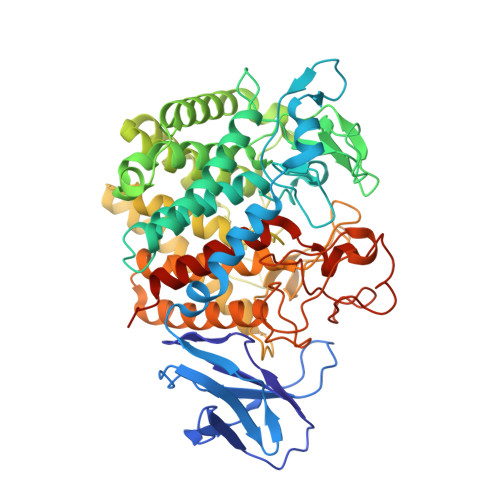The crystal structure of an inverting glycoside hydrolase family 9 exo-beta-D-glucosaminidase and the design of glycosynthase.
Honda, Y., Arai, S., Suzuki, K., Kitaoka, M., Fushinobu, S.(2016) Biochem J 473: 463-472
- PubMed: 26621872
- DOI: https://doi.org/10.1042/BJ20150966
- Primary Citation of Related Structures:
5DGQ, 5DGR - PubMed Abstract:
Exo-β-D-glucosaminidase (EC 3.2.1.165) from Photobacterium profundum (PpGlcNase) is an inverting GH (glycoside hydrolase) belonging to family 9. We have determined the three-dimensional structure of PpGlcNase to describe the first structure-function relationship of an exo-type GH9 glycosidase. PpGlcNase has a narrow and straight active-site pocket, in contrast with the long glycan-binding cleft of a GH9 endoglucanase. This is because PpGlcNase has a long loop, which blocks the position corresponding to subsites -4 to -2 of the endoglucanase. The pocket shape of PpGlcNase explains its substrate preference for a β1,4-linkage at the non-reducing terminus. Asp(139), Asp(143) and Glu(555) in the active site were located near the β-O1 hydroxy group of GlcN (D-glucosamine), with Asp(139) and Asp(143) holding a nucleophilic water molecule for hydrolysis. The D139A, D143A and E555A mutants significantly decreased hydrolytic activity, indicating their essential role. Of these mutants, D139A exclusively exhibited glycosynthase activity using α-GlcN-F (α-D-glucosaminyl fluoride) and GlcN as substrates, to produce (GlcN)2. Using saturation mutagenesis at Asp(139), we obtained D139E as the best glycosynthase. Compared with the wild-type, the hydrolytic activity of D139E was significantly suppressed (<0.1%), and the F(-)-release activity also decreased (<3%). Therefore the glycosynthase activity of D139E was lower than that of glycosynthases created previously from other inverting GHs. Mutation at the nucleophilic water holder is a general strategy for creating an effective glycosynthase from inverting GHs. However, for GH9, where two acidic residues seem to share the catalytic base role, mutation of Asp(139) might inevitably reduce F(-)-release activity.
Organizational Affiliation:
Ishikawa Prefectural University, 1-308 Suematsu, Nonoichi, Ishikawa 921-8836, Japan [email protected].















